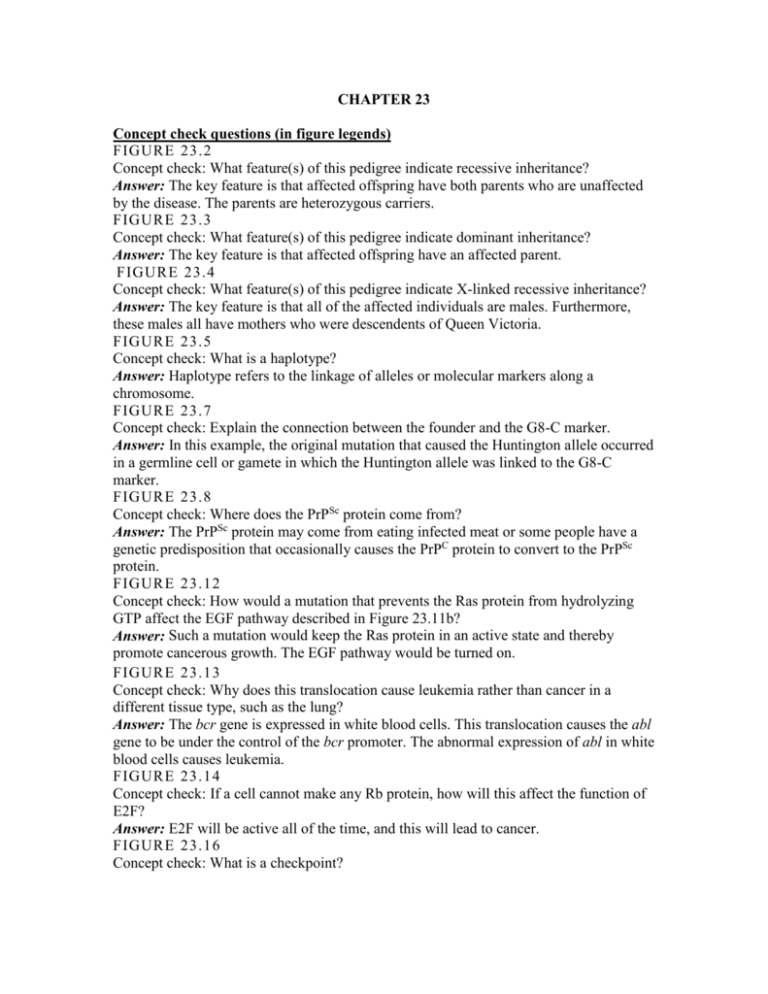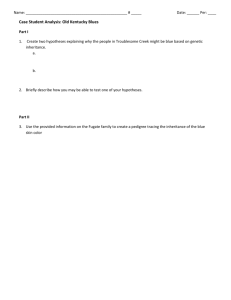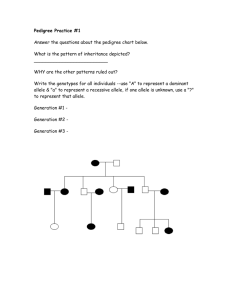CHAPTER 23
advertisement

CHAPTER 23 Concept check questions (in figure legends) FIGURE 23.2 Concept check: What feature(s) of this pedigree indicate recessive inheritance? Answer: The key feature is that affected offspring have both parents who are unaffected by the disease. The parents are heterozygous carriers. FIGURE 23.3 Concept check: What feature(s) of this pedigree indicate dominant inheritance? Answer: The key feature is that affected offspring have an affected parent. FIGURE 23.4 Concept check: What feature(s) of this pedigree indicate X-linked recessive inheritance? Answer: The key feature is that all of the affected individuals are males. Furthermore, these males all have mothers who were descendents of Queen Victoria. FIGURE 23.5 Concept check: What is a haplotype? Answer: Haplotype refers to the linkage of alleles or molecular markers along a chromosome. FIGURE 23.7 Concept check: Explain the connection between the founder and the G8-C marker. Answer: In this example, the original mutation that caused the Huntington allele occurred in a germline cell or gamete in which the Huntington allele was linked to the G8-C marker. FIGURE 23.8 Concept check: Where does the PrPSc protein come from? Answer: The PrPSc protein may come from eating infected meat or some people have a genetic predisposition that occasionally causes the PrPC protein to convert to the PrPSc protein. FIGURE 23.12 Concept check: How would a mutation that prevents the Ras protein from hydrolyzing GTP affect the EGF pathway described in Figure 23.11b? Answer: Such a mutation would keep the Ras protein in an active state and thereby promote cancerous growth. The EGF pathway would be turned on. FIGURE 23.13 Concept check: Why does this translocation cause leukemia rather than cancer in a different tissue type, such as the lung? Answer: The bcr gene is expressed in white blood cells. This translocation causes the abl gene to be under the control of the bcr promoter. The abnormal expression of abl in white blood cells causes leukemia. FIGURE 23.14 Concept check: If a cell cannot make any Rb protein, how will this affect the function of E2F? Answer: E2F will be active all of the time, and this will lead to cancer. FIGURE 23.16 Concept check: What is a checkpoint? Answer: A checkpoint is a point in the cell cycle in which proteins detect if the cell is in the proper condition to divide. If an abnormality such as DNA damage is detected, the checkpoint proteins will halt the cell cycle. FIGURE 23.19 Concept check: Explain why familial breast cancer shows a dominant pattern of inheritance in a pedigree even though it is recessive at the cellular level. Answer: An individual with a predisposition for familial breast cancer inherits only one copy of the mutant allele. Therefore, it shows a dominant pattern of inheritance. However, to actually get breast cancer, the other allele must become mutant in somatic cells.











